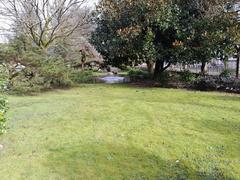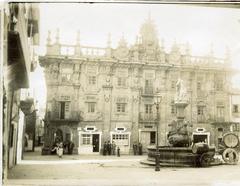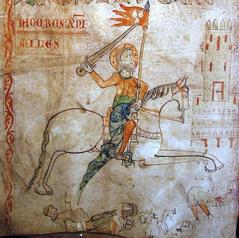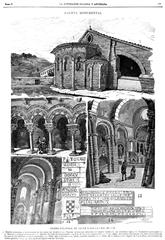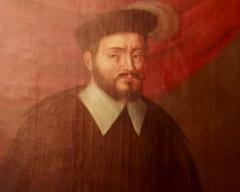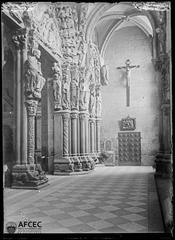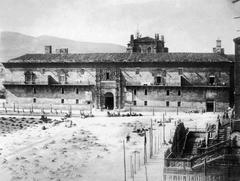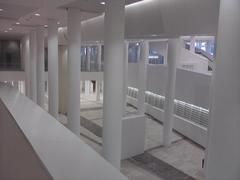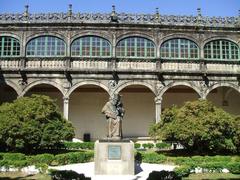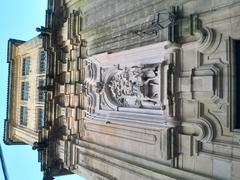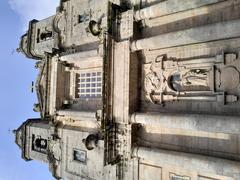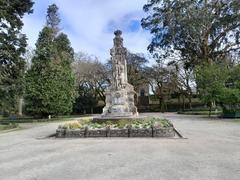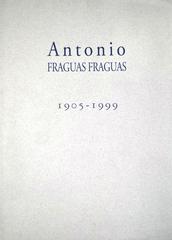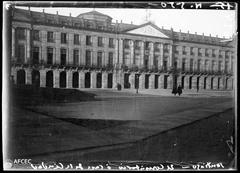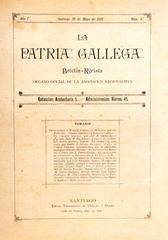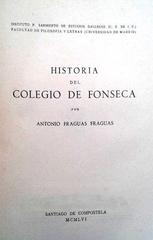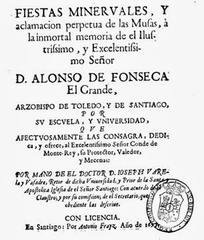
Muralla de Santiago de Compostela: Visiting Hours, Tickets, and Travel Guide
Date: 04/07/2025
Introduction
The Muralla de Santiago de Compostela, the medieval city wall that once encircled the historic heart of Santiago de Compostela, Spain, offers a fascinating glimpse into the city’s storied past. Built to protect one of Christianity’s most revered pilgrimage destinations, the wall is both a symbol of resilience and a vital piece of urban heritage. This guide provides a thorough exploration of the Muralla’s history, architectural evolution, cultural significance, visiting hours, ticketing details, accessibility, travel tips, and nearby attractions—equipping visitors with all they need to make the most of their experience in this UNESCO World Heritage city (Eupedia; World Travel Guide; UNESCO).
Contents
- Historical Overview
- Origins and Construction
- Architectural Evolution
- Decline and Preservation
- Cultural and Strategic Significance
- Defensive Role and Urban Identity
- Symbolism for Pilgrims and Citizens
- Urban Development and Social Structure
- City Growth and Organization
- Political Autonomy
- Legacy and Conservation
- Visitor Information
- Visiting Hours and Access
- Tickets and Guided Tours
- Accessibility
- Practical Travel Tips
- Special Events
- Nearby Attractions
- Visual and Interactive Resources
- Frequently Asked Questions (FAQ)
- Summary and Visitor Recommendations
- Sources and Further Reading
Historical Overview
Origins and Construction
The origins of the Muralla de Santiago de Compostela are closely tied to the city’s rise as a major Christian pilgrimage center. Following the legendary discovery of Saint James the Apostle’s tomb in the 9th century, Santiago de Compostela grew rapidly in religious and political importance. The earliest fortifications appeared between the 10th and 11th centuries, constructed using local granite to protect the city from external threats such as Viking raids and Moorish incursions. These early walls encircled not only the cathedral precinct but also emerging neighborhoods that catered to the steady influx of pilgrims (World Travel Guide; UNESCO).
Architectural Evolution
Initially, the walls consisted of simple granite curtain walls with defensive towers and monumental gates. As the city flourished—particularly from the 11th to 13th centuries—fortifications were expanded and reinforced, enclosing new districts and religious institutions. The perimeter eventually extended to over two kilometers, punctuated with up to seven main gates, including the Porta do Camiño (the gateway for pilgrims), Porta da Pena, Porta Faxeira, and the Mazarelos Arch, the latter being the only surviving gate today (Nomads Travel Guide).
The walls typically measured 2–3 meters thick and up to 8 meters high, with regular towers and barbicans. Many of these features have been lost to urban expansion, but sections remain visible and have been restored for public appreciation (Explorial).
Decline and Preservation
The city’s defensive needs declined with advancements in military technology and periods of peace. From the 18th century onward, large segments of the wall were dismantled or incorporated into new buildings. Today, only scattered wall fragments and the Mazarelos Arch stand as testimony to the original circuit. Conservation efforts focus on stabilization, integration into the urban landscape, and visitor education (Galicia Travels).
Cultural and Strategic Significance
Defensive Role and Urban Identity
The Muralla was essential in protecting Santiago’s residents and sacred relics during times of conflict. The walls regulated the flow of people and goods, serving as checkpoints for toll collection and maintaining the city’s economic vitality. Within the walls, the city developed a distinctive medieval layout, with narrow streets radiating from the cathedral (UNESCO; Eupedia).
Symbolism for Pilgrims and Citizens
For medieval pilgrims, passing through the city gates marked the emotional culmination of their journey along the Camino de Santiago. The walls and gates thus became thresholds between the secular and sacred, reinforcing Santiago’s spiritual aura. The Muralla has remained a powerful symbol in local legends, processions, and festivals (Forwalk.org).
Urban Development and Social Structure
City Growth and Organization
The Muralla delineated the medieval city, concentrating population and activity within its bounds. As the city expanded, suburbs developed outside the walls but the walled core retained its primacy, especially for religious, administrative, and commercial life (World Travel Guide).
Political Autonomy
As the seat of the archbishopric and a major pilgrimage hub, Santiago enjoyed privileges from monarchs and popes. The walls were crucial in asserting autonomy and safeguarding these rights during periods of political upheaval (UNESCO).
Legacy and Conservation
Although much of the original Muralla has been lost or integrated into modern structures, its legacy endures in city street names, local traditions, and surviving architectural fragments. Restoration projects and the city’s UNESCO World Heritage status help to preserve these remnants for future generations (UNESCO; Galicia Travels).
Visitor Information
Visiting Hours and Access
Most surviving sections of the Muralla, such as the Mazarelos Arch, are in public spaces and freely accessible year-round. The best time to visit is during daylight hours, typically from 9:00 AM to 7:00 PM in spring and summer, with shorter hours in winter for guided tours or museums (Nomads Travel Guide; AtickettoTakeoff).
Tickets and Guided Tours
Access to outdoor wall remnants is free. Admission fees may apply for museums such as the Museo das Peregrinacións or for guided tours, which generally cost between €10–€20 per person. Tours are recommended for deeper historical insight and may include access to otherwise restricted fragments (Ultreya Tours).
Accessibility
The historic old town features cobblestone streets and some uneven terrain. While some restored sections and museums are wheelchair accessible, others may present challenges. Visitors with mobility issues should consult local tourism offices for detailed accessibility information.
Practical Travel Tips
- Footwear: Wear comfortable shoes for walking on cobblestones.
- Timing: Visit early mornings or weekdays to avoid crowds.
- Photography: The Mazarelos Arch offers excellent photo opportunities, especially at sunset.
- Sustainability: Respect signage and avoid climbing on remains to help preserve the site (Caminosantiago Compostela).
Special Events
The area around the Muralla hosts cultural events, religious processions, and festivals throughout the year—many of which re-enact historic routes and celebrate Santiago’s heritage.
Nearby Attractions
- Cathedral of Santiago de Compostela: The city’s spiritual heart.
- Praza do Obradoiro: Main square adjacent to the cathedral.
- Monastery of San Martiño Pinario: A major religious complex.
- Museo das Peregrinacións: Museum dedicated to the pilgrimage tradition and city history.
- Plaza de Abastos: The main market, adjacent to wall fragments (Galicia Travels).
Visual and Interactive Resources
High-quality images and virtual tours are available via official tourism sites. Interactive maps can help visitors trace the original wall’s path and locate surviving fragments.
Frequently Asked Questions (FAQ)
Q: What are the Muralla de Santiago de Compostela’s visiting hours?
A: Outdoor remnants are accessible year-round, typically from 9:00 AM to 7:00 PM in spring and summer. Museums and guided tours have specific schedules; check official sources.
Q: Do I need tickets to visit the wall?
A: Outdoor sites are free. Museum entry and guided tours require tickets.
Q: Is the site accessible for people with disabilities?
A: Some areas are accessible; others, especially older or integrated fragments, may be challenging. Consult local tourism offices for details.
Q: When is the best time to visit?
A: Early mornings, weekdays, and off-season months offer a quieter experience.
Q: Are guided tours available?
A: Yes; several local operators provide tours focused on the Muralla’s history and surviving gates.
Summary and Visitor Recommendations
The Muralla de Santiago de Compostela is more than a relic; it is a living symbol of the city’s resilience, faith, and urban evolution. Exploring the surviving walls, particularly the Mazarelos Arch, alongside Santiago’s other historical sites, enriches any visit. Take advantage of guided tours, interactive resources, and local festivals for a multidimensional experience. For up-to-date information, always consult the official tourism website or visitor center (Nomads Travel Guide; Galicia Travels; Ultreya Tours).
Sources and Further Reading
- Eupedia
- World Travel Guide
- UNESCO
- Nomads Travel Guide
- Ultreya Tours
- AtickettoTakeoff
- Galicia Travels
- UNESCO Canopy
- Caminosantiago Compostela
Image Suggestions:
- Photograph of the Mazarelos Arch with alt text: “Mazarelos Arch, the surviving gate of Muralla de Santiago de Compostela.”
- Map showing the original and surviving sections of the wall with alt text: “Map of Santiago de Compostela’s medieval city wall and seven gates.”
- Images of wall fragments at Azabachería 39 and near Plaza de Abastos.
- Photos of the Museo das Peregrinacións and cultural events along the wall.
Internal Links:
- Guide to the Cathedral of Santiago de Compostela
- Camino de Santiago pilgrimage route overview
- Santiago de Compostela’s top historical sites

